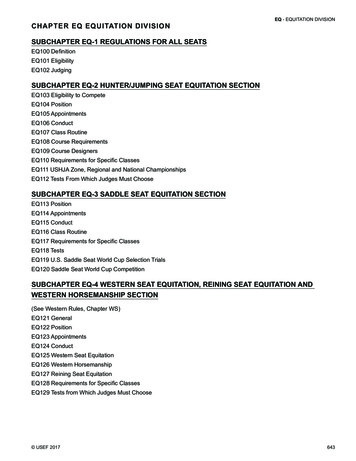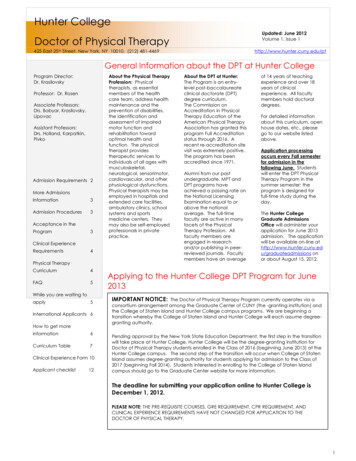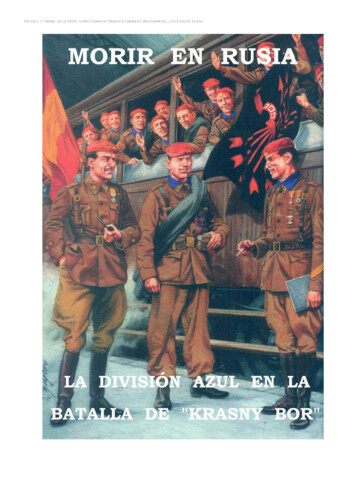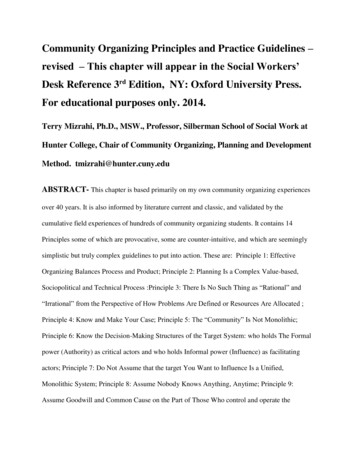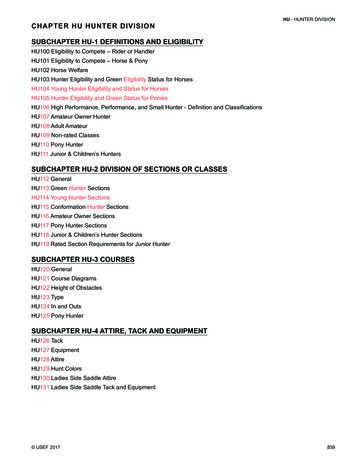
Transcription
CHAPTER HU HUNTER DIVISIONHU - HUNTER DIVISIONSUBCHAPTER HU-1 DEFINITIONS AND ELIGIBILITYHU100 Eligibility to Compete – Rider or HandlerHU101 Eligibility to Compete – Horse & PonyHU102 Horse WelfareHU103 Hunter Eligibility and Green Eligibility Status for HorsesHU104 Young Hunter Eligibility and Status for HorsesHU105 Hunter Eligibility and Green Status for PoniesHU106 High Performance, Performance, and Small Hunter - Definition and ClassificationsHU107 Amateur Owner HunterHU108 Adult AmateurHU109 Non-rated ClassesHU110 Pony HunterHU111 Junior & Children’s HuntersSUBCHAPTER HU-2 DIVISION OF SECTIONS OR CLASSESHU112 GeneralHU113 Green Hunter SectionsHU114 Young Hunter SectionsHU115 Conformation Hunter SectionsHU116 Amateur Owner SectionsHU117 Pony Hunter SectionsHU118 Junior & Children’s Hunter SectionsHU119 Rated Section Requirements for Junior HunterSUBCHAPTER HU-3 COURSESHU120 GeneralHU121 Course DiagramsHU122 Height of ObstaclesHU123 TypeHU124 In and OutsHU125 Pony HunterSUBCHAPTER HU-4 ATTIRE, TACK AND EQUIPMENTHU126 TackHU127 EquipmentHU128 AttireHU129 Hunt ColorsHU130 Ladies Side Saddle AttireHU131 Ladies Side Saddle Tack and Equipment USEF 2017859
HU - HUNTER DIVISIONSUBCHAPTER HU-5 JUDGINGHU132 GeneralHU133 Definition of CompetedHU134 SoundnessHU135 ConformationHU136 PerformanceHU137 FaultsHU138 Pony HunterHU139 Junior & Children’s HunterSUBCHAPTER HU-6 CLASS SPECIFICATIONSHU140 Under Saddle and Hack ClassesHU141 Model Classes for Green Conformation Hunter 3’6” and High Performance Conformation HunterHU142 Green Hunter, Young Hunter, High Performance and Performance Hunter ClassesHU143 Amateur Owner ClassesHU144 Adult Amateur ClassesHU145 Ladies Side Saddle ClassesHU146 Hunter ClassicsHU147 Pony HunterSUBCHAPTER HU-7 CHAMPIONSHIPSHU148 GeneralHU149 EligibilityHU150 TiesHU151 Combination Hunter ChampionshipHU152 Pony HunterHU153 Junior & Children’s HunterSUBCHAPTER HU-8 CONDUCTHU154 VeterinarianHU155 JudgesHU156 Course DesignersHU157 SchoolingHU158 Back to Back ClassesHU159 Jumping OrderHU160 Entry FeesHU161 SchedulingHU162 CancellationsHU163 Prize MoneyHU164 Challenge TrophiesHU165 Pony HunterHU166 Junior & Children’s Hunter860 USEF 2017
SUBCHAPTER HU-9 SPECIAL RATING REQUIREMENTSHU - HUNTER DIVISIONHU167 Sections Required for National RatingHU168 Sections Required for Regional I RatingHU169 Sections Required for Regional II RatingHU170 Pony HunterSUBCHAPTER HU-10 MEASUREMENTHU171 GeneralHU172 Required Measurements and Re-measurementsHU173 Membership Requirements and FeesHU174 Completing the Measurement FormHU175 Measurement DeviceHU176 Measurement SurfaceHU177 Position of AnimalHU178 Method of MeasurementHU179 Re-MeasurementHU180 Protesting HeightHU181 Federation Measurement VerificationHU182 Measurement AppealHU183 Official MeasurementSUBCHAPTER HU-11 NATIONAL CHAMPIONSHIPSHU184 Hunter BreedingHU185 Pony HunterHU186 Junior HunterHU187 Amateur Owner Hunter ChampionshipsSUBCHAPTER HU-12 HUNTER & PONY HUNTER BREEDINGHU188 GeneralHU189 Hunter BreedingHU190 Pony Hunter BreedingSUBCHAPTER HU-13 USHJA CHAMPIONSHIPS AND SPECIAL CLASSESHU191 International Hunter DerbyHU192 USHJA National Hunter DerbyHU193 USHJA Green Hunter ChallengeHU194 USHJA Pony Hunter DerbyHU195 International Hunter Derby Welcome StakesSUBCHAPTER HU-14 LIMITING ENTRIESHU196 Limiting EntriesAppendix A. Hunter Schooling Rules USEF 2017861
HU - HUNTER DIVISIONCHAPTER HU HUNTER DIVISIONWHEN A SUBJECT IS NOT ADDRESSED IN THESE RULES, IT MUST BE ADDRESSED BY THE APPROPRIATECOMMITTEE AND THAT COMMITTEE’S INTERPRETATION WILL STAND AS THE RULE UNTIL THE NEXT YEARWHEN AN APPROPRIATE RULE CHANGE WILL BE SUBMITTED.SUBCHAPTER HU-1 DEFINITIONS AND ELIGIBILITYHU100 Eligibility to Compete – Rider or HandlerIn order to compete in any Hunter, Hunter Breeding, Pony Hunter Breeding, Junior Hunter, or Pony Hunter classesat licensed competitions as an exhibitor, rider, trainer, or his/her agent(s), a person must be an Active member of theUnited States Hunter Jumper Association, Inc., or pay a Show Pass fee to the United States Hunter Jumper Association, Inc. Exception: Local Competitions, competitions restricted to a particular breed, classes restricted to breeds withFederation Recognized National Affiliate status, and exceptions listed in GR901.9.HU101 Eligibility to Compete – Horse & Pony1. USHJA Horse Registrations.a. All horses competing in Federation licensed and/or USHJA sanctioned competitions with Hunter, Hunter Breeding, Jumper and Hunter/Jumping Seat Equitation classes not restricted by breed must be properly identified inaccordance with GR1101, and must also be registered with USHJA (see GR1101.1). The USEF/USHJA registration number for each horse must be entered on all entry forms for licensed competitions.b. Applications for USHJA Registration can be completed online at www.ushja.org or www.usef.org using theUSEF Horse Registration application form. This form is also available from the USHJA or Federation office, as adownload from the USHJA or Federation website or from competition management. Competition management isresponsible for notifying exhibitors of this requirement in their prize list.2. The Hunter Division is open to horses, stallions, mares or geldings. (For rules pertaining to exhibitors who are 18years of age or older riding ponies, see HU110.11.)3.1 In addition to the provisions of HU 101.1, on or after December 1, 2017, all horses competing in classes thatrequire USHJA horse registration must provide a microchip number that verifies their animal’s identity in order tocompete for points, money won or be eligible for Federation and/or USHJA programs and awards where horses arerequired to be recorded or registered.3.2 A microchip used to verify identity must be a fifteen digit ISO compliant 11784/11785 chip and be implanted in thenuchal ligament of the animal.3.3 This rule will have a transition period from December 1, 2017 to November 30, 2018. During this period, animalsthat are not in compliance with this rule will not receive points or be eligible for Federation and/or USHJA programsand awards. After this period, all horses that are competing in classes which require USHJA registration which arenot microchipped will be ineligible to compete in Federation licensed competitions.4. The Hunter Breeding Section is open to horses only.a. Horses shown as a Thoroughbred must have been either registered with The Jockey Club or meet one of thecriteria below. All competitions must require verification of registration on the day of the competition through oneof the following methods:1. The Jockey Club Certificate of Foal registration or a copy thereof2. The horse’s lip tattoo, the horse’s 5-cross pedigree and the successful tattoo lookup result from The JockeyClub’s Tattoo Identification Services, (located at www.registry.jockeyclub.com)3. If neither of the above is available, a letter from The Jockey Club verifying the horse’s identity.5. Pony Hunter Breeding classes are open to ponies.862 USEF 2017
6. Stallions are prohibited from all Pony Hunter classes except breeding classes.HU - HUNTER DIVISION7. Stallions are prohibited from all Junior and Children’s’ Hunter classes.8. Ponies shown by a junior cannot be shown by an adult at the same competition, except in breeding classes in-handand in accordance with HU110. Ponies shown by an adult at a Licensed Competition cannot compete in any sectionsor classes at the same competition with a junior rider. (Exception: Breed restricted classes at multi-breed/disciplinecompetitions. BOD 1/16/16 Effective 12/1/16, BOD 11/7/16 Effective 12/1/16HU102 Horse Welfare1. The following acts are prohibited:a. Riding an exhausted horse.b. Excessive pressuring of a tired horse.c. Riding or lungeing an obviously lame horse.d. Excessive use of a whip on any horse in a stall, aisle, schooling area, competition ring or elsewhere on thecompetition grounds. The use of a whip must be for a good reason, done at the appropriate time, in the properplace and with appropriate restraint. Excessive whipping will not be tolerated.e. Any striking of the horse’s head (on the poll or forward of the poll shall be deemed excessive.f. Repeated jerking on the reins and sawing on the bit unless applied to an unruly horse that is jeopardizing hisown safety or the safety of his rider.g. Improper use of the bit resulting in bleeding, broken skin or broken mucous membrane.h. Excessive use of the spurs or spurring resulting in broken and bleeding skin.i. Rapping the legs of a horse with the butt end of a riding crop or other implement.j. Use of any substance to induce temporary heat causing hyper-sensitization.k. Poling.l. Use of a wire or chain in conjunction with any schooling jumps.m.Use of electronic shock devices in schooling or showing.n. Use of shackles, hock hobbles and similar devices, with the exception of kicking chains while the horse is inthe stall or in transport. This does not prohibit the use of rubber or plastic exercising devices.o. Showing a horse with hypersensitive, raw or bleeding sores around the cornets, pasterns, legs or body.p. Use of laser beam devices anywhere on the competition grounds, except in an exhibition or if required inclass specifications. (Exception: Lasers used in a therapeutic manner).q. Withholding of feed or water for prolonged periods.r. Letting blood from a horse for other than diagnostic purposes.s. Inhumane treatment of a horse in a stall, aisle, schooling area, competition ring or elsewhere on the competition grounds, by any person.2. Regular and local competitions. Competitors found to be in violation of these rules by the Competition Steward orother Federation Official shall be eliminated/disqualified from competing within the upcoming 24-hour period andshall forfeit all entry fees for such competition. In addition after consultation between Competition Management,the Steward, or other official involved, and a Senior Judge in the division, additional penalties including disqualification from the balance of the competition may be imposed. All such violations must be recorded in the Steward’sReport and, if cruelty or abusive behavior is evident, it will be reviewed by the Federation for such action as may bedeemed appropriate to the particular circumstances.HU103 Hunter Eligibility and Green Eligibility Status for Horses1. In all cases, the hunter eligibility and green status of the horse is the responsibility of the owner.2. Hunter eligibility for a horse begins when a horse of any age, competes for the first time in any over fences class USEF 2017863
HU - HUNTER DIVISIONwith jumps at three feet (3’0”) in height or higher in any Hunter or Hunter/Jumping Seat Equitation classes or sections held at a Federation or Equine Canada Licensed competition in North America.a. For the purposes of eligibility, equivalent heights are:3’0”.90 meter3’3”1.0 meter3’6”1.10 meter3’9”1.20 meter3. Once a horse begins its hunter eligibility, competing in jumper classes affects its Green Status and Eligibilityaccording to HU103.12.4. Horses may enter the Green Hunters in any height section for which they are eligible. Further eligibility in theGreen Hunter section is determined by the height section in which they enter the system.5. A horse may compete in only one Green Hunter fence height section at any one competition.6. When a horse begins its hunter eligibility competing in hunter or equitation classes or sections with fence heights of3’0” - 3’5”, it remains eligible for Green Hunter 3’0” and 3’3” for two competition years (not necessarily consecutive).a. A horse that competes in any Hunter or Hunter/Jumping Seat Equitation class at a recognized competition in theUnited States or Canada with fence heights of 3’6” or higher is no longer eligible to compete in the Green Hunter3’0” section but remains eligible to compete in the Green Hunter 3’3” section.b. A horse may compete in any other hunter or equitation class with fence heights a maximum of 3’6” if otherwiseeligible at a maximum of four (4) competitions in one competition year prior to August 1 and remain eligible tocompete in the Green Hunter 3’3”. The following competition year in which a horse competes in any hunter orequitation class at a Federation or Equine Canada Licensed competition in North America with fence heights of3’6” or higher is considered the horse’s Green Hunter 3’6” year regardless of the number of times it competes.c. A horse that competes over fences 3’6” or higher in any Hunter or Equitation class after August 1st is no longereligible for the 3’3” section and is only eligible to compete in the Green Hunter 3’6” section for the remainder ofthe competition year. That competition year will be considered the horse’s Green Hunter 3’6” year.d. Once a horse competes in hunter or equitation classes at a Federation or Equine Canada licensed competitionin North America with fences 3’6” or higher at five (5) or more competitions in one year, it is no longer eligible forthe Green Hunter 3’3” section. At this time the horse is only eligible to compete in the Green Hunter 3’6” sectionfor the remainder of the competition year. That competition year will be considered the horse’s Green Hunter 3’6”year.e. For jumper restrictions see HU103.127. Once a horse competes in a Federation or USHJA National Championship/Event with fence heights of 3’6” orhigher he is no longer eligible for the Green Hunter 3’0” or 3’3” sections.8. Following a horse’s Green Hunter 3’6” year, it is eligible to compete in the Green Hunter 3’9” section for one year.That one year will commence the next competition year that the horse competes in any hunter or equitation classat a Federation or Equine Canada Licensed competition in North America with fence heights of 3’6” or higher. Forjumper restrictions see HU103.12.9. A horse that has completed his Green Hunter 3’9” year is no longer eligible for any Green Hunter section.10. Once a horse begins its hunter eligibility, the following jumper restrictions apply:a. To remain eligible for Green Hunter 3’0 and 3’3”, a horse may not compete in a jumper class at a Federation orEquine Canada Licensed competition in North America with fence heights higher than 3’3” (or 1.0m when classspecifications list fence height in metric).b. To remain eligible for Green Hunter 3’6”, a horse may not compete in a jumper class at a Federation or EquineCanada Licensed competition in North America with fence heights higher than 3’6” (or 1.10m when class864 USEF 2017
specifications list fence height in metric).HU - HUNTER DIVISIONc. To remain eligible for Green Hunter 3’9”, a horse may not compete in a jumper class at a Federation or EquineCanada Licensed competition in North America with fence heights higher than 3’9” (or 1.20m when class specifications list fence height in metric).11. In all cases, fence heights will be determined by the specifications of each section regardless of whether or not thefences are actually set at the regulation height.12. If a competition starts prior to or on November 30th Green status at the start of the competition is maintainedthroughout the competition. BOD 11/7/16 Effective 12/1/16 BOD 1/14/17 Effective 2/1/17HU104 Young Hunter Eligibility and Status for Horses1. Young Hunter age restrictions are defined as:a. Young Hunter 3’0” – horses five years of age and underb. Young Hunter 3’3” – horses six years of age and underc. Young Hunter 3’6” – horses seven years of age and under2. Horses eligible for the Young Hunters may begin competing in any Young Hunter height section for which they areeligible. Further eligibility in the Young Hunter section is determined by the height section in which they enter thehunter eligibility system. (see HU104.6-9)3. A horse is eligible to compete in an age-restricted hunter class from December 1 of the competition year in whichthey reach the applicable age at any time during that same competition year.4. Age of horse must be verified in accordance with Federation policies and procedures prior to competing for awardsin the Young Hunter sections. Age can be verified using only the following documents:a. Registration papers or Certificate of Pedigree from a breed or sport horse registry.b. Passport issued by a World Breed Federation Sport Horse (WBFSH) recognized registry.5. A horse may compete in only one Young Hunter height section at any one competition.6. When a horse begins its hunter eligibility competing in any Hunter or Hunter/Jumping Seat Equitation class orsection with fence heights of 3’0” - 3’5”, it remains eligible for Young Hunter 3’0” and 3’3” for two competition yearsprovided it is eligible by age.a. For the purposes of eligibility, equivalent heights are:3’0”.90 meter3’3”1.0 meter3’6”1.10 meter3’9”1.20 meterb. A horse that competes in any hunter or equitation class at a Federation or Equine Canada Licensed competitionin North America with fence heights of 3’6” or higher is no longer eligible to compete in the Young Hunter 3’0”section but remains eligible to compete in the Young Hunter 3’3” section if otherwise eligible.c. A horse may compete in any other hunter or equitation class with fence heights of a maximum of 3’6” at a maximum of four (4) competitions in one competition year prior to August 1 and remain eligible to compete in theYoung Hunter 3’3”. The following competition year in which a horse competes in any hunter or equitation classat a Federation or Equine Canada Licensed competition in North America with fence heights of 3’6” or higher isconsidered the horse’s Young Hunter 3’6” year regardless of the number of times it competes.d. A horse that competes over fences 3’6” or higher in any Hunter or Equitation class after August 1st is no longereligible for the 3’3” section and is only eligible to compete in the Young Hunter 3’6” section for the remainder ofthe competition year. That competition year will be considered the horse’s Young Hunter 3’6” year.e. Once a horse competes in hunter or equitation classes at a Federation or Equine Canada licensed competitionin North America with fences 3’6” or higher at five (5) or more competitions in one year, it is no longer eligible for USEF 2017865
HU - HUNTER DIVISIONthe Young Hunter 3’3” section. At this time the horse is only eligible to compete in the Young Hunter 3’6” sectionfor the remainder of the competition year. That competition year will be considered the horse’s Young Hunter 3’6”year.f. For jumper restrictions see HU104.117. Once a horse competes in a Federation or USHJA National Championship/Event with fence heights of 3’6” orhigher, it is no longer eligible for the Young Hunter 3’3” section.8. A horse that has completed his Young Hunter 3’6” year is no longer eligible for any Young Hunter section.9. Once a horse begins its hunter eligibility, the following jumper restrictions apply:a. To remain eligible for Young Hunter 3’0 and 3’3”, a horse may not compete in a jumper class at a Federation orEquine Canada Licensed competition in North America with fence heights higher than 3’3” ( or 1.0m when classspecifications list fence height in metric).b. To remain eligible for Young Hunter 3’6”, a horse may not compete in a jumper class at a Federation or EquineCanada Licensed competition in North America with fence heights higher than 3’6” ( or 1.10m when class specifications list fence height in metric).10. In all cases, fence heights will be determined by the specifications of each section regardless of whether or not thefences are actually set at the regulation height.11. If a competition starts prior to or on November 30th, Young Hunter status at the start of the competition is maintained throughout the competition. BOD 11/7/16 Effective 12/1/16 BOD 1/14/17 Effective 2/1/17HU 105 Hunter Eligibility and Green Status for Ponies1. In all cases, the hunter eligibility and green status of the pony is the responsibility of the owner.2. Determining Hunter eligibility for ponies. Hunter eligibility for a pony begins when a pony of any age, competes forthe first time in any over fences class with jumps at 2’3” or higher for small ponies, 2’6” or higher for medium poniesand 2’9” or higher for large ponies in Hunter or Hunter/Jumping Seat Equitation classes or sections held at a Federation or Equine Canada Licensed competition in North America.a. For the purposes of eligibility, equivalent heights are:2’3”.70 meter2’6”.80 meter2’9”.85 meter3’0”.90 meter3. Determining Green Status for ponies. Ponies that have not broken their Green Status must jump less than theirregulation height or their Green Status will be broken. The Green status of a pony is determined by the followingfactors in competition experience at Hunter or Hunter /Jumping Seat Equitation classes or sections held at a Federation or Equine Canada Licensed competition in North America:a. The height of fences (determined by the class, section or division specifications) over which a pony hascompeted.b. The number of competition years a pony has competed at regulation height. A pony that has competed in suchclasses for one (1) or more competition years, without receiving a reinstatement, is no longer eligible to competein the Green section.4. In all cases, fence heights will be determined by the specifications of each section regardless of whether or not thefences are actually set at the regulation height.5. If a competition starts prior to or on November 30th, Green status at the start of the competition is maintainedthroughout the competition.6. Green Pony Status.a. a. A green pony is a pony not exceeding 14.2 hands of any age, which is eligible to compete in the Green Pony866 USEF 2017
HU - HUNTER DIVISIONsection. A pony’s Green Hunter eligibility, regardless of age, begins the first time the pony competes in any overfences class with jumps at 2’3” or higher for small ponies, 2’6” or higher for medium ponies and 2’9” or higherfor large ponies in Hunter or Hunter/Jumping Seat Equitation classes or sections held at a Federation or EquineCanada Licensed competition in North America.b. A pony is eligible to compete as a Green Pony for a maximum of one (1) year regardless of age or change tomeasurement status. A pony that has changed height sections in its green year may complete the green year atits new height.c. In its first year of showing at regulation height or higher, a green pony may also compete in the Regular PonyHunter section at its respective height.d. Once a pony begins competing in any class that restricts Green status, it may no longer compete in any Jumperclass held at a Federation or Equine Canada Licensed competition in North America or it will lose its Green status.e. A Pony Hunter Green reinstatement may be granted one time. A pony is not eligible for a green reinstatement if ithas competed in the US Hunter and/or Jumper Pony Championship.7. Green Pony Reinstatement. A pony cannot return to compete in the section for which the reinstatement applicationwas made until written notification has been received from the Federation that the reinstatement has been granted.A pony’s eligibility to compete in restricted sections may be reinstated for a future competition year provided that:a. The pony was not shown at the regulation height or higher at more than four (4) competitions prior to September1st of the current competition year.b. The pony was not shown at the regulation height or higher on or after September 1st of the current competitionyear.c. The pony no longer competes at the regulation height or higher immediately upon application for reinstatement.d. The pony is otherwise eligible for a reinstatement under Federation rules. BOD 1/16/16 Effective 12/1/16e. The horse or pony is actively recorded with the Federation at the time of the request. If the horse or pony is notactively recorded at the time of request, it must be recorded/renewed at that time. If the horse or pony is notrecorded/renewed at the time of application, the reinstatement request will automatically be denied.HU106 High Performance, Performance and Small Hunter – Definition and Classifications1. A High Performance or Performance Hunter is a horse of any age and is not restricted by previous showing.2. High Performance Huntera. Championships must be offered in accordance with HU148.b. Number of classes and prize money must be offered in accordance with GR312.6.c. Individual classes may be entered. (Exception: Under Saddle classes. See HU140.2)d. In a section with three (3) classes, the under saddle will count half points towards champion and reserve.e. The High Performance section must offer the greatest amount of prize money of all hunter sections at the competition. (Exception: When the High Performance Hunter section is combined with the Performance Hunter or USEF 2017867
HU - HUNTER DIVISIONthe Green Hunter, see HU112) BOD 11/7/16 Effective 12/1/163. Performance Hunter 3’6”a. Championships must be offered in accordance with HU148.b. Number of classes and prize money must be offered in accordance with GR312.6.c. Individual classes may be entered. (Exception: Under Saddle classes. See HU140.2)d. In a section with three (3) classes, the under saddle will count half points towards champion and reserve.4. Performance Hunter 3’3”a. Championship and Reserve must be offered in accordance with HU148.b. Number of classes and prize money must be offered in accordance with GR312.6.c. Individual classes may be entered. (Exception: Under Saddle classes. See HU140.2)d. In a section with three (3) classes, the under saddle will count half points towards champion and reserve.5. Small Huntera. Fences set at 3’.b. Championships must be offered in accordance with HU148.c. This section will be C rated for Horse Of The Year Awards as per GR312.6.d. Individual classes may be entered.e. A small hunter is a horse over 14.2 hands and not to exceed 15 hands 2 1/2 inches.b. A measurement card is required for all horses entered as per HU171.6. Thoroughbred Huntera. Thoroughbred restricted classes are open only to horses that are registered with USHJA and are in possessionof Breed Registry papers. Horses must have been either registered with The Jockey Club or meet one of thecriteria below. All horse shows must require riders to verify registration on the day of the horse show through oneof the following methods:1. The Jockey Club Certificate of Foal Registration or a copy thereof2. The horse’s lip tattoo, the horse’s 5-cross pedigree and the successful tattoo lookup result from The JockeyClub’s Tattoo Identification Services, (located at www. registry.jockeyclub.com)3. If neither of the above is available, a letter from The Jockey Club verifying the horse’s identity.b. Fences set at 3’0” spreads not to exceed height of fence. Cross entry into other sections is allowed unless otherwise stated in the prize list.c. Championships must be offered in accordance with HU148.d. This section will be C rated for Zone Horse of the Year Awards as per GR312.6.HU107 Amateur Owner Hunter1. To be ridden by Amateur Owners or an amateur member of the owner’s family. In either case classes are restrictedto riders who are no longer eligible to compete as junior exhibitors. Leased horses are not eligible and multipleownership is not permitted unless all owners are members of the same family.2. An amateur who competes for a person outside of his/her family may not compete in a class restricted to AmateurOwners at the same competition. Exceptions:a. Equitation classes,b. Under Saddle classes,c. and a maximum of one (1) horse not owned by the rider, or his/her family, in jumper sections and a maximumof one (1) horse not owned by the rider or his/her family in hunter sections, in classes not restricted to amateurowners. (For Amateur rules please see GR1306)3. If an Under Saddle class is divided by age and a rider has two or more horses entered, provided at least one horseis ridden by the Amateur Owner or an amateur member of the owner’s family, the additional horse(s) entered may868 USEF 2017
be ridden by another amateur regardless of rider’s age.HU - HUNTER DIVISIONHU108 Adult Amateur1. Competitions must offer Adult Amateur Hunter sections in accordance with the specifications of the applicable USHJA zone. Unless the USHJA submits their Zone specifications to the Federation by August 1 of the previous year, thefollowing specifications will apply for the Adult Amateur Hunter section:a. To be ridden by exhibitors who have reached their 18th birthday as of December 1 of the current competitionyear and who hold a current Federation Amateur Status.b. Heights for Adult Amateur Hunter may range between 2’9” -3’3” with spreads not to exceed fence height.c. If there are fewer than six (6) entries in any divided section, the sections must be combined. If there are six (6) ormore entries in each divided section the divided sections must be held separately.d. Horses and riders entered in the Adult Amateur Hunter sections may not compete in the Amateur Owner Huntersection at the same competition. Riders entered in the Adult Amateur Hunter sections may not compete in anyother class in which obstacles are required to exceed 3’9” (1.15m) at the same competition. (Exception: USHJANational Hunter Derby).e. Horses may be entered in Junior Hunter sections at the same competition if ridden by a member of the same family.f. Ponies may be ridden by adults, however ponies shown by adults at a Licensed Competition cannot be shownby juniors at the same competition. (Exception: when competing at a multi-breed/discipline competition, a ponymay be shown in the breed restricted hunter section by an adult and then also shown by a junior rider in hunterclasses restricted to ponies).g. Cross entry into other sections is allowed unless otherwise stated in the prize list.2. If an under saddle class is divided by age and a rider has two or more horses entered, all riders must be amateursbut need not be eligible by age.3
download from the USHJA or Federation website or from competition management. Competition management is responsible for notifying exhibitors of this requirement in their prize list. 2. The Hunter Division is open to horses, stallions, mares or geldings. (For rules pertaining to exhibitor

